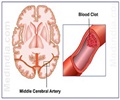A new study suggests that composition of plaque deposits in the carotid arteries indicate a patient’s risk of having a stroke
A new study by researchers at the University of Virginia Health System suggests that composition of plaque deposits in the carotid arteries indicate a patient’s risk of having a stroke.
Published in the March edition of Stroke, the study looked retrospectively at the composition of plaque deposits in the carotid arteries of 102 patients treated at UVa. Its findings suggest that, in determining who is most likely to have a stroke, physicians may want to take a closer look at the type of plaque building up in their patients’ arteries.According to Dr. Christopher Kramer, a professor of Radiology and Medicine at UVa and study team member, risk assessments for stroke have traditionally focused on the degree to which arterial plaque has constricted blood flow. 'You might say, we’ve been worried about the size of the river channel,' he explains. 'This study and others like it indicate we also need to pay attention to the river bank and to the kind of silt that’s accumulating there.'
Using computed tomography (CT) angiogram images from UVa’s patient database, the researchers measured calcified and noncalcified plaque in carotid arteries as well as total plaque volume. 'There’s a lot of controversy about whether calcium in plaque is a marker of stability or instability,' Dr. Kramer explains. 'When plaque in the coronary and carotid arteries is unstable, it is thought to lead to heart attack and stroke, respectively.'
Study findings show that patients with plaque that is more than 45 percent calcified had a low risk of having preceding symptoms of stroke or aborted stroke known as a transient ischemic attack (TIA). 'We found that it’s the proportion, rather than the percent blockage, of calcified plaque that is associated with stability in patients with narrowed arteries,' Dr. Kramer notes.
In current clinical practice, physicians look at the percent blockage in the carotid artery to identify candidates for plaque clearing surgery to prevent stroke. The new findings suggest that calcification percentages should also be considered. According to Dr. Kramer, prospective studies of patients who have not yet developed symptoms are needed to confirm the diagnostic value of calcified plaque measurements.
The UVa researchers believe that improved risk assessments for stroke will lead to better decisions about when to intervene surgically. Even though plaque-removal procedures save many lives each year, they can cause complications and in some cases result in stroke or death.
Advertisement
The researchers assessed MDCT images of patients with artery blockages of 50 percent or more. The study group included 35 patients who had suffered a stroke or had other neurological symptoms. The remaining 67 had no history of symptoms.
Advertisement
PRI/S











